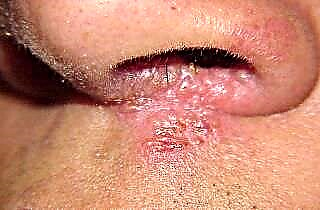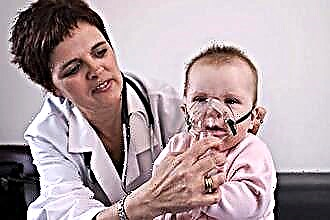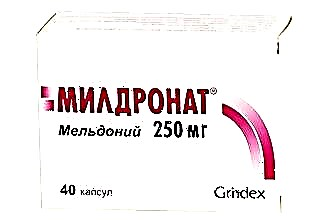Nose wounds are familiar to everyone. These include dry crusts that prevent proper breathing, inflamed hair follicles and pimples, deep wounds and ulcers in the nasal mucosa, and cracks in the nose. These sores are symptoms of various diseases: from inflammation of the skin to chancre (a manifestation of syphilis). The etiology of ulcers is different, respectively, and the approach to treatment is individual.
Diseases provoking problems with the mucous membrane
 A furuncle is a purulent protrusion on the skin that occurs as a result of the vital activity of staphylococci. The inflammatory process begins with a small red spot, later a dense subcutaneous node forms. The skin becomes bright red, the painful sensations of the affected tissues intensify. This disease appears due to reduced immunity and the ingress of pyogenic microbes into the nasal passages. Furuncles can appear on any part of the body one at a time (general furunculosis) or several pieces on one area of the skin (carbuncle).
A furuncle is a purulent protrusion on the skin that occurs as a result of the vital activity of staphylococci. The inflammatory process begins with a small red spot, later a dense subcutaneous node forms. The skin becomes bright red, the painful sensations of the affected tissues intensify. This disease appears due to reduced immunity and the ingress of pyogenic microbes into the nasal passages. Furuncles can appear on any part of the body one at a time (general furunculosis) or several pieces on one area of the skin (carbuncle).- Sycosis of the nostrils is a pustular skin disease caused by Staphylococcus aureus. Sycosis appears on the scalp and forms in groups in the form of discs, spreading to adjacent areas of the skin. The painful area is covered with an accumulation of pustules, their base is dense, scarlet in color. After the pustules dry up, the skin is covered with crusts of yellow or green color. They periodically disappear, but due to the ongoing inflammatory process inside the body, they arise again. Sycosis is often associated with eczema, which complicates the diagnosis.
- Herpes is a viral infection that damages the mucous membranes. Unclear watery formations pop up in the nasal passages, hiding erosion and ulcers under a thin film.
- Eczema of the entrance to the nose is a disease that occurs most often with purulent rhinitis and sinusitis. Nasal mucus, active blowing out and cleansing of the nasal passages with a finger injure the mucous membrane.
Regular mechanical damage to the nose provokes the appearance of painful areas. There are times when the eczema in the nose is part of the eczema of the whole body.
- Erysipelas is a disease caused by infection with streptococcus, less often - staphylococcus, as a result of mechanical damage to the skin. Often goes from inflammation on the facial skin. The disease can be caused by reduced immunity, squeezing out purulent acne near the nose, as well as operations on the nose, in its cavity and in the paranasal sinuses.
- Rhinophyma and rosacea is a chronic skin inflammation that mainly affects elderly men. These ailments appear in the form of red nodular rashes, similar to the comb of a rooster. Prolonged illness leads to deformity.
- Polypous degeneration of the nasal mucosa. The patient can easily notice polyps in the nose. They look smooth and whitish in color. In a neglected form, they tend to grow outside the nose, absolutely blocking breathing.
 Syphilis and other infectious diseases. A dense, painful area of skin with an ulcer in the center is one of the symptoms of syphilis. Various wounds and abscesses can be a manifestation of HIV infections.
Syphilis and other infectious diseases. A dense, painful area of skin with an ulcer in the center is one of the symptoms of syphilis. Various wounds and abscesses can be a manifestation of HIV infections.- Ozena (fetid rhinitis) is a mucosal disease. The nasal secretion dries up, forms crusts with an unpleasant odor and covers the entire surface of the mucous membrane. The process extends to the bony walls of the nose.
- Benign and malignant formations. Oncological diseases of the nose at first look like a bleeding and growing ulcer. With soft papilloma, a growth resembling broccoli forms in the nasal passage.
- Diphtheria of the nose. A rare disease that occurs mainly in children. The cause of the disease is corynebacteria, which provoke the appearance of ulcers on the wings of the nose, drying up into the crusts, and white plaque in the nostril. Symptoms appear simultaneously with signs of pharyngeal diphtheria.
- Allergic rashes as a reaction to cosmetics, nasal ointments and aerosols.
To summarize, it is safe to say that an ulcer in the nose indicates the presence of an infection. The colonization of bacteria and their reproduction occurs due to reduced immunity, dry air and mechanical damage to the nasal passages.
Why the wound in the nose does not heal
The main symptoms of wounds are itching and pain. Without treatment, the process can become chronic and cause serious complications.
 If the wound in the nose does not heal, this means that the inflammatory process is progressing and the infection becomes chronic. This happens when the disease in the acute phase of manifestation has not been completely cured or has not been treated at all. The infection has thoroughly settled in a person and makes itself felt at the slightest decrease in immunity. A weakened body is unable to cope with microbes on its own. They colonize and cause disease over and over again.
If the wound in the nose does not heal, this means that the inflammatory process is progressing and the infection becomes chronic. This happens when the disease in the acute phase of manifestation has not been completely cured or has not been treated at all. The infection has thoroughly settled in a person and makes itself felt at the slightest decrease in immunity. A weakened body is unable to cope with microbes on its own. They colonize and cause disease over and over again.
Before treating sores, you need to find out what caused them to appear. To do this, you first need to identify the causative agent of the infection that lives in the nose. After ENT, he prescribes the necessary course of treatment. To obtain positive results, you should take therapy seriously and follow all the doctor's recommendations.
The stable appearance of wounds in the nose may indicate general diseases. For example, in diseases of the gastrointestinal tract, dermatological rashes and mucosal suppuration often occur. Inflammation in the nose and itching can be symptoms of diabetes.
Temperature and humidity in the room also play an important role. With dry air, the mucous membrane becomes thinner. In such an environment, microbes develop more actively, which also contributes to the incessant inflammatory process in this area.
If the course of treatment was completed, but did not bring any effect, it is possible that the therapy was chosen incorrectly. It is completely useless to treat wounds with herpes ointment if the patient is tormented by syphilis chancre. An excess of medications will also not benefit the patient and may even complicate the situation. Timely consultation with a specialist will help you recover quickly and without complications.
Bacteriological nasal culture
Bacterial culture is a laboratory analysis that determines pathogenic microorganisms and their susceptibility to drugs. For sowing, mucus is collected from the nasal passages and sent for examination. Its essence lies in the placement of biological material in special conditions. The thermostat sets the required humidity and temperature for the growth of bacteria. After some time, the analysis of the colonies of microorganisms is carried out. Their shape, color, density are evaluated, concentration and quantity are determined. Bacteriological culture reveals streptococci, pneumococci, corynebacterium diphtheria, Haemophilus influenzae, meningococci, etc.
It is very important to have a nasal culture before starting antibiotics, as they significantly distort the results. If antibiotic therapy has taken place, it is advisable to carry out bacterial culture 10 days after stopping antibiotics. Sowing should only be done in proven medical centers and clinics. The sterility of the instruments, compliance with the rules for collecting material and the speed of its delivery to the laboratory affect the quality and information content of the bacterial culture results.

The data on bacterial culture from the nose will be ready no earlier than in 3 days.From them, the patient will learn the name of the infection, the degree of concentration of pathogens and receive an antibiogram (determination of the susceptibility and resistance of the infection to certain antibiotics). Based on the results of bacterial culture, your ENT will prescribe an appropriate treatment regimen.
Staphylococcus aureus on the nasal mucosa
Staphylococcus aureus is one of the most common bacteria living in the human mucosa. This microbe most often attacks people with chronic diseases. Its presence in small quantities does not pose any threat to the normal functioning of the body. It becomes dangerous when a person's immunity weakens and the number of bacteria grows steadily. There are about 20 types of staphylococci. Hemolytic staphylococcus is a pathological species and is sown in almost half of patients with chronic diseases of the nasopharynx. A large amount of Staphylococcus aureus in the nose negatively affects healthy cells in the body, destroying and destroying them.
The microbe is quite resistant to many antibacterial drugs, and is also capable of mutating, which greatly complicates the treatment. Often staphylococcal infection appears in the body by self-infection against the background of reduced immunity.
 The mucous membrane is a favorable environment for pathogenic bacteria, therefore, the infection most often settles in this area. They say about the active reproduction of staphylococcus:
The mucous membrane is a favorable environment for pathogenic bacteria, therefore, the infection most often settles in this area. They say about the active reproduction of staphylococcus:
- excessive overflow of the vessels of the circulatory system in the nose;
- difficulty breathing;
- inability to perceive odors;
- coryza with profuse purulent discharge;
- irritation in the nose;
- the appearance of purulent formations on the outside and inside of the nose;
- the spread of infection to the sinuses and the development of sinusitis.
Preventive measures
Avoid sticking fingers or objects into your nasal passages forever. The vast majority of patients do this unconsciously every minute. Strengthen immunity in all possible ways:
- eat right;
- go in for sports;
- temper your body;
- take natural immunomodulators and vitamins as needed;
- moisten the nasal mucosa with saline solutions;
- use a humidifier.
Also, keep good hygiene: wash your hands regularly, use a personal towel and washcloth.
Be attentive to yourself and healthy!

 A furuncle is a purulent protrusion on the skin that occurs as a result of the vital activity of staphylococci. The inflammatory process begins with a small red spot, later a dense subcutaneous node forms. The skin becomes bright red, the painful sensations of the affected tissues intensify. This disease appears due to reduced immunity and the ingress of pyogenic microbes into the nasal passages. Furuncles can appear on any part of the body one at a time (general furunculosis) or several pieces on one area of the skin (carbuncle).
A furuncle is a purulent protrusion on the skin that occurs as a result of the vital activity of staphylococci. The inflammatory process begins with a small red spot, later a dense subcutaneous node forms. The skin becomes bright red, the painful sensations of the affected tissues intensify. This disease appears due to reduced immunity and the ingress of pyogenic microbes into the nasal passages. Furuncles can appear on any part of the body one at a time (general furunculosis) or several pieces on one area of the skin (carbuncle). Syphilis and other infectious diseases. A dense, painful area of skin with an ulcer in the center is one of the symptoms of syphilis. Various wounds and abscesses can be a manifestation of HIV infections.
Syphilis and other infectious diseases. A dense, painful area of skin with an ulcer in the center is one of the symptoms of syphilis. Various wounds and abscesses can be a manifestation of HIV infections.

